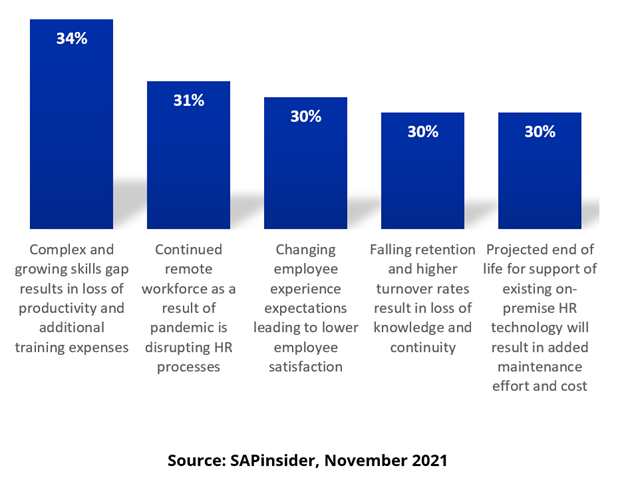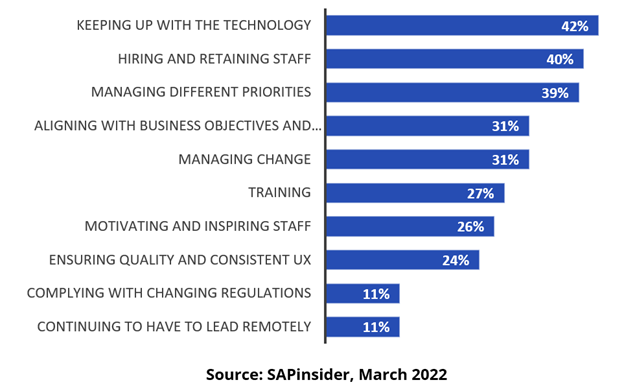Growing Skills Gap Emphasizing Importance of Training and Retention
Meet the Experts
The Great Resignation, also called The Great Reshuffling, left many companies scrambling to find the skills they needed to run their business in 2021 and early 2022. With experienced workers leaving a void that can’t immediately be replaced by staff on hand, a growing skills gap that had been a topic of conversation years before 2021 suddenly came into greater focus. In our latest Human Capital Management (HCM) research, we found it to be among the top drivers for Human Resources (HR) technology strategy among our respondents.
Top Drivers for HR Technology Strategy

This has affected executive priorities at SAPinsider organizations. When looking at our Executive Forum research, we see that hiring and retention rose to one of the top challenges facing technology leaders in 2022. Meanwhile, training jumped from a negligible challenge in 2021 to being a top challenge at over a quarter of respondents’ organizations.
Top Challenges for Tech Leaders

How Can Companies Address the Skills Gap?
In our HCM research, we also found that while companies most often were driven by the skills gap, training and upskilling was among their lowest cited HR strategies. It’s possible that companies feel they have the right training programs available; it’s just a matter of improving the efficiency and experience of learning through other more common actions such as automation or self-service.
In fact, respondents with greater levels of satisfaction with their HR processes and technologies were much more likely to focus on enabling self-service. Making learning and upskilling more accessible to employees could lead to greater expansion of skills across the workforce—and eliminate some of the need for recruiting and hiring to fill the skills gap.
Retention is also a key piece—and building an environment where employees want to work is likely to lead to lower turnover and the potential of avoiding a skill gap issue in the first place. Beyond obvious measures such as increased compensation and better benefits, the top companies are also addressing retention through offering better technology experiences and streamlining mundane processes through automation. Investing in employees through upskilling is also a strategy for creating more loyalty.
However, even the best companies will lose people from time to time, and that’s why top organizations are more likely to invest in cloud recruiting solutions like SAP SuccessFactors Recruiting. They are seeking the latest in talent acquisition tools and looking to extend that high quality employee experience to the candidate experience.
What This Means for SAPinsiders
Make employee satisfaction a core requirement of your HR technology strategy. Ultimately, if companies want to avoid a skills gap through reduced turnover and higher retention, they are going to need to provide a more satisfying experience for their employees. A happy employee will stick around longer — so when deciding how to approach your HR transformation, find out what your employees want and build that into your processes. The most satisfied respondents were 15% more likely to promote increased employee satisfaction through better experiences.
Evaluate the impact of an employee’s journey from the beginning. Recruiting and onboarding solutions are being used or implemented at just 36% and 29% of respondents’ organizations, respectively; however, they are the top two technologies in planning or evaluation mode. Onboarding is being evaluated or planned to be implemented at 69% of organizations, while recruiting is at 63%. This suggests companies are beginning to understand the importance of a first impression when it comes to meeting requirements — particularly in areas such as talent acquisition and retention.
Identify areas for training and learning improvement. If your organization has a skills gap, training up employees will have double benefit—they will have new skills to help the business, and they are likely to feel more loyalty to the company. Find ways to make your learning tools easier to use and ensure employees have the time to learn.









